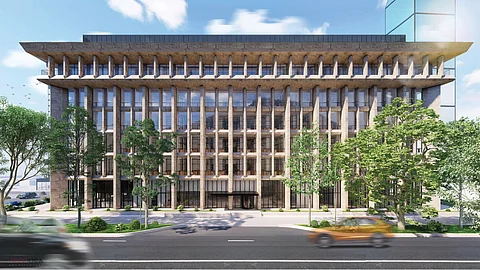
- Destinations
- Experiences
- Stay
- What's new
- Celebrating People
- Responsible Tourism
- CampaignsCampaigns
- Subscribe
- Buy Now

One of Europe’s oldest capitals, Tbilisi is a cosmopolitan city that wears its Byzantine, Neoclassical, Middle Eastern and Soviet influences proudly on its sleeve. Its history and culture make it an attractive destination for Indians, 124,335 of whom visited Georgia in 2024—a 46.8 per cent increase from the year before.
Besides the traditional sulfur baths, array of medieval places of worship, exciting nightlife and botanical gardens that typically feature on a visitor’s itinerary, a tour of the city’s brutalist architecture that is emblematic of its Soviet past is also a must.
One of the best examples of the Soviet modernist style is a former central post office that has now been converted into one of Tbilisi’s swankiest hotels. Built in the 1970s on Rustaveli Avenue, the building had a distinctive façade, grand cornices and double atriums that quickly made it an architectural landmark. It acted as a vital communication hub during the Soviet period in Georgia (1921-1991), handling letters, postcards and telegrams as well as fielding calls before the technology became commonplace in most households.
As one of the finest examples of Soviet modernist style, it was awarded a National State Award in 1983.
Since its 20th-century heyday, the central post office has undergone a transformation that retains its mid-century modernism with an infusion of contemporary classical design. The newly launched Telegraph Hotel’s 239 rooms are a lesson in luxury living, featuring refined interiors and minimalist design that evokes comfort and simplicity.
Paying homage to the building’s function as a public space, the architectural firm Neri & Hu installed floor-to-ceiling glazing to allow passersby a peek into the hotel's public spaces, including its five different restaurants and a small library. The use of glass instead of solid walls to divide these different spaces established sight lines deep into the building from the street, extending Tbilisi's public space right into the heart of the hotel.
The Telegraph Hotel's location on Rustaveli Avenue is fortuitous as well, as the street is home to many cultural institutions, such as the Georgian National Gallery, the Georgian Museum of Fine Arts, the Rustaveli Drama Theatre, the Zurab Tsereteli Museum of Modern Art, the Kashveti Church, the Tbilisi Conservatory, the Tbilisi Opera House, and the Georgian National Museum.
Considered the centre of Tbilisi, this is one of the most important landmarks in the city. It was founded in the early 19th century but was given its present name after the Russian Revolution of 1917. In the 1950s, a monument to Lenin was erected on the square but was demolished in 1991 and replaced by a fountain. In 2006, a 40-m column with a statue of Saint George at its top, created by the famous sculptor Zurab Tsereteli, was installed.
The Kashveti Church of St George is a Georgian Orthodox Church that was constructed between 1904 and 1910. Its name is derived from the Georgian words kva (“stone”) and shva (“to give birth”). Legend has it that a sixth-century monk named David of Gareja was accused by a woman of getting her pregnant. David prophesied his denial would be proved when she gave birth to a stone, and he was proved right.
The church consists of a cross-dome, three-church structure, with Italian marble used in its construction. Its frescos were made with one of the most difficult and ancient methods of encaustic painting, which involves adding coloured pigments to a heated wax medium. Paintings made in this way can survive for centuries.
One of Georgia’s most modern art museums, this institution has a collection of 3,500 works from up to 80 artists covering the period from 1945 to the present day. Works from the fall of the Soviet Union, the Cold War, the Georgian Civil War and Georgian Independence are depicted across 31 rooms and three stairwells.
Before entering the building, visitors are greeted by a sculpture of an eagle that adorns the outer façade. This was inspired by the eagles found in the caves of Vani, which date back to the ninth and first centuries BCE.
May to October, when the weather is pleasant and the city is less crowded. Summer is great for festivals, while winter (December to February) suits those seeking a quieter vibe.
A two-night stay for one person in September 2025 starts from approximately INR 52,000.
IndiGo flies directly from Delhi to Tbilisi; otherwise, you will have to stopover at Baku, Doha or Sharjah.
Yes. Apply for an e-visa at https://www.evisa.gov.ge/GeoVisa/. However, passengers with a visa issued by certain countries do not need to apply for one. You can find the complete list online.
